The Complete Checklist: Does Your Chatbot Have These Vital Features?

Kasturi Goswami
September 26, 2024
13 min

Table of Contents
Summary is AI-generated
What are the key features of an AI chatbot?
AI chatbots come with a range of features designed to enhance user experience and streamline interactions. Some key features include:
- Natural language processing for understanding user input
- Machine learning capabilities for continuous improvement
- Multi-channel support for seamless communication
- Personalization for tailored responses
- Integration with backend systems for retrieving relevant information
These features work together to create a powerful AI chatbot that can handle various tasks efficiently and effectively.
Two years back, the sudden rise in commercial AI usage had experts predicting that chatbots would soon be the primary customer service channel for businesses.
Today, though the market is growing, the shifting customer experience ecosystem and the endless possibilities of AI have raised expectations. Now, investing in a basic chatbot that answers FAQs or handles routine queries isn’t enough.
If you are a small or medium-sized business owner with a chatbot that misses the mark, the consequences can be dire. It is high time you asked yourself: Is my chatbot doing enough for my business?
You need something more than functional. But how do you decide which chatbot would be the one?
Well, we have the answer for you - a comprehensive checklist of AI chatbot features you must consider to make sure your chat assistant isn’t just showing up but excelling.
Before diving into the specifics, here’s a quick look at the top 11 AI chatbot features your SMB needs to truly excel in today’s diluted business ecosystem.
- Natural Language Processing (NLP) for human-like conversations.
- Knowledge base integration for personalized responses.
- Machine learning to improve performance continuously.
- Contextual understanding to deliver relevant, follow-up information.
- Customization to reflect your brand's voice and identity.
- Automated task handling to manage repetitive processes efficiently.
- Human handoff capability for smooth transitions to human agents when necessary.
- Multilingual support to cater to global audiences.
- Multi-channel integration for consistent cross-platform interactions.
- API integration to connect seamlessly with other systems.
- Analytics and reporting to track performance and make data-driven improvements.
AI Chatbot Features Meant for the Modern Business Maker
1. Natural Language Processing (NLP)
Your chatbot should be able to provide a human-like experience.
Chatbots are meant to be around-the-clock human substitute assistants for your customers. People prefer interacting with them when it feels and gives off a human vibe, meaning an artificial intelligence that can recognize, understand, and generate human-like language, making interactions intuitive and natural.
Dashly conducted interviews with companies that use chatbots and found that 50% of customers like to talk with AI chatbots.
Natural Language Processing is the secret behind a bot’s instinctual answers. It uses a combination of computational linguistics, statistical modeling, machine learning, and deep learning to generate text and speech. NLP allows chatbots to recognize user intent, making them the driving force behind meaningful interactions.
For your business: NLP-powered chatbots cultivate a more responsive, engaging customer experience that will drive satisfaction and loyalty in the long run.
Thinkstack helps create a free GPT powered chatbot for your needs. It offers several model options including GPT-3.5 Turbo, GPT-4o Mini, GPT-4o, and GPT-4 Turbo, each with varying levels of NLP capabilities to enhance your chatbot’s ability to understand and respond to human language in a natural and engaging way.
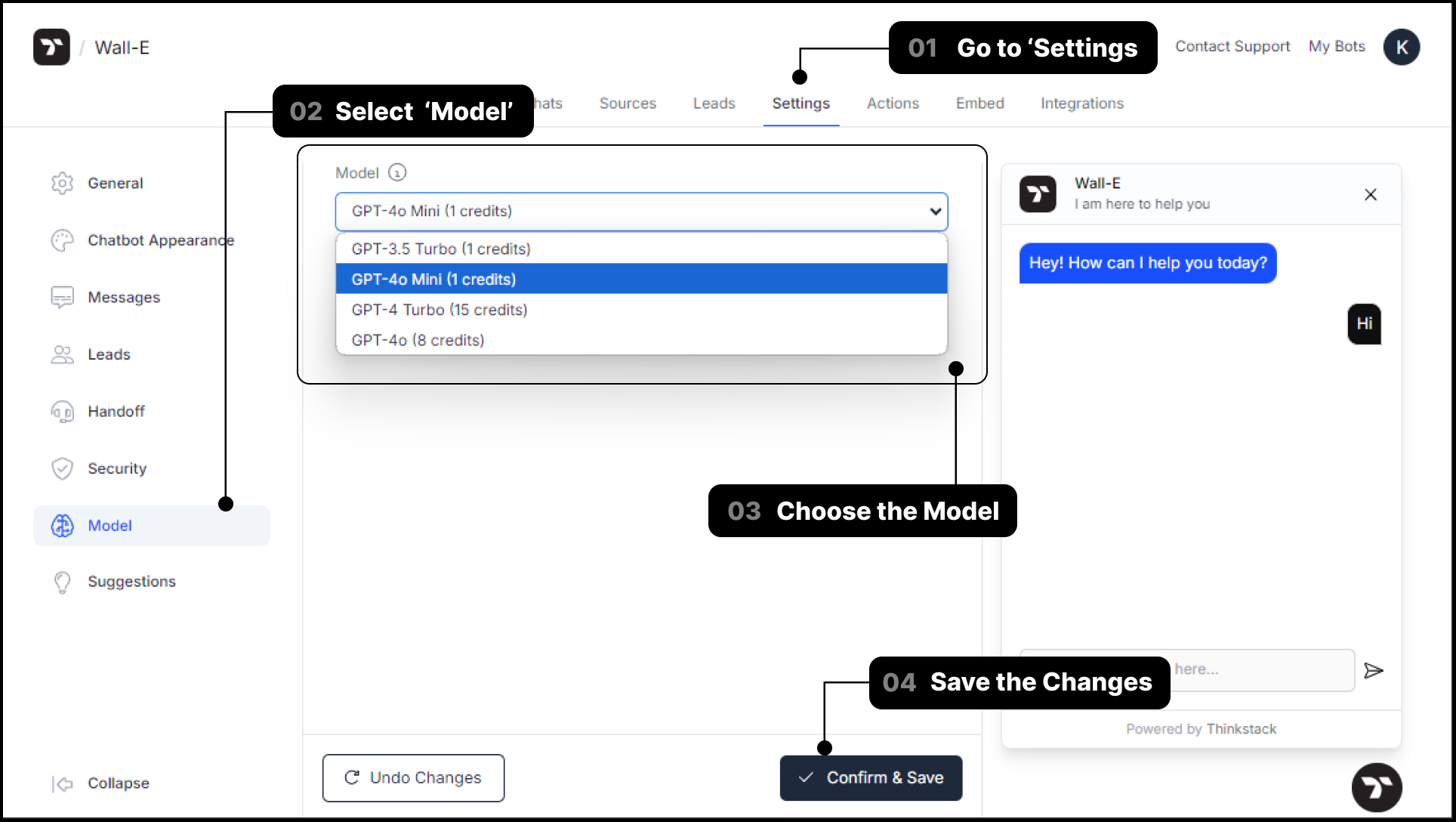
2. Knowledge base integration
Your chatbot should know your company inside out.
No one knows your business as well as you do. Your chatbot should be aware of it to serve your customers well within the limits of your business offerings. Knowledge base integration is the answer.
This AI chatbot feature allows your chatbot to be trained with specific data. This enables the bot to provide accurate, personalized responses based on your knowledge. As the chatbot continues to learn from this information, it becomes a more reliable source for your customers, offering swift, precise answers to their queries.
For your business: There is a reduction in human intervention and an enhancement in the customer experience.
Your chatbot is as good as the data it is trained on. Use Thinkstack’s free AI chatbot maker to build one trained on your data, be it website URL, pdf, text, or API feed.
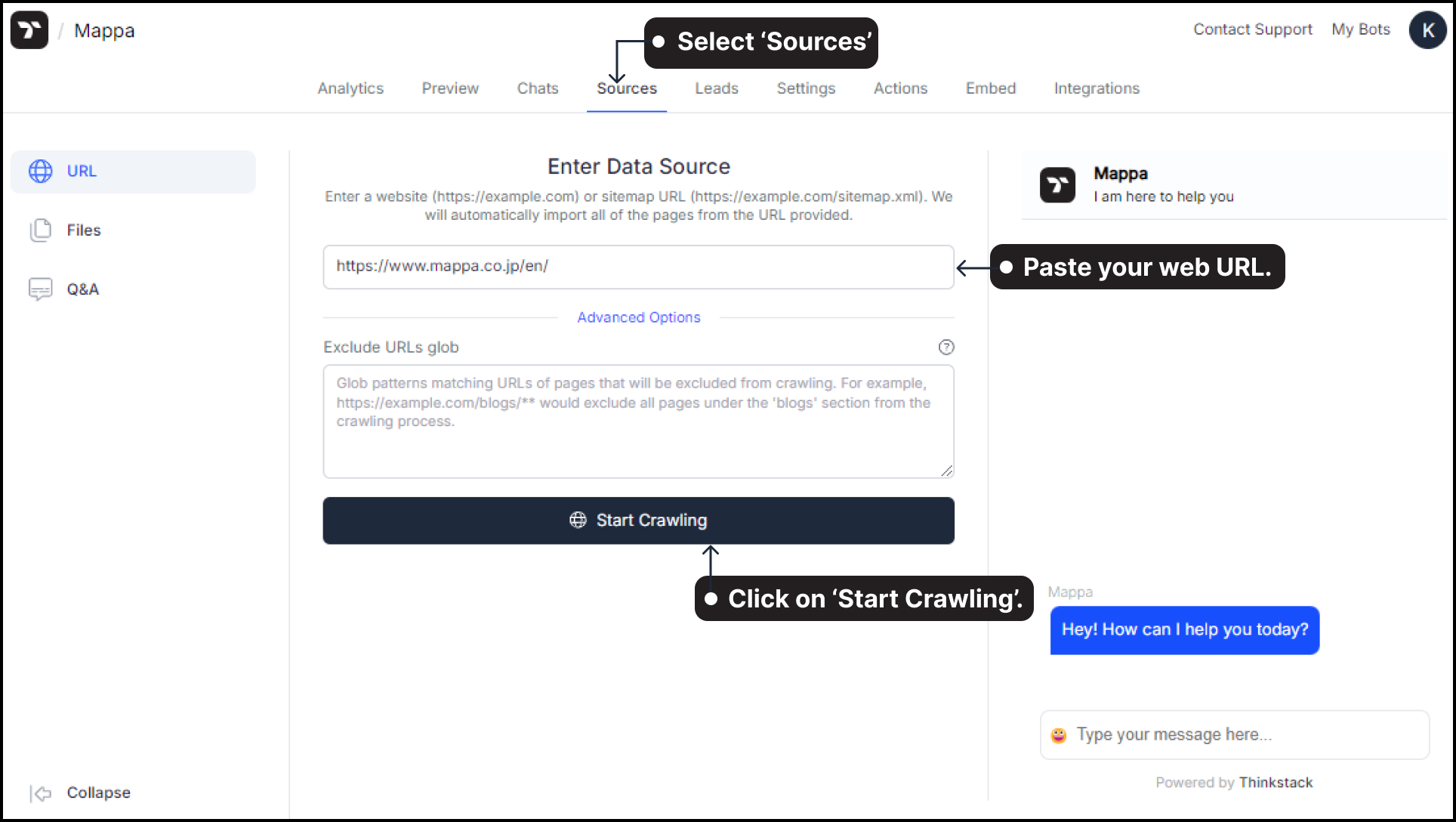
3. Machine Learning capabilities
Your chatbot should get smarter over time.
A chatbot that learns from each interaction is like an employee who gets better at their job every day. The more it talks, the smarter it gets.
Think of it like a customer service rep who learns on the job. If your chatbot answers a specific question five times today, by tomorrow, it should have nailed the response.
That’s the beauty of continuously learning. Your chatbot becomes capable of analyzing past interactions and identifying patterns, improving over time and refining its ability to help.
For your business: Your chatbot evolves alongside your business and customer needs, learning to juggle the shifting demands.
4. Contextual understanding
Your chatbot should be able to understand the bigger picture.
Chatbots must have an inherent contextual understanding capability. This allows them to recall previous customer interactions and respond accordingly, even if the conversations span multiple sessions.
For instance, if your chatbot recalls a user’s previous inquiry about one of your products, it can provide more accurate follow-up information, enhancing the user experience.The AI chatbot feature enables your bot to anticipate user needs and offer proactive suggestions, making the conversation more engaging and helping users find solutions quickly.
For your business: Boosting satisfaction by providing personalized, relevant responses, leading to coherent and relevant interactions.
Ready to enhance your chatbot’s performance with intelligent suggestions?
By incorporating guided conversation flows, you empower your customers to make informed, productive decisions. Thinkstack’s no-code, free AI chatbot maker offers the perfect solution. With its Suggestions feature, your chatbot will proactively guide users, simplify tasks, and boost sales.
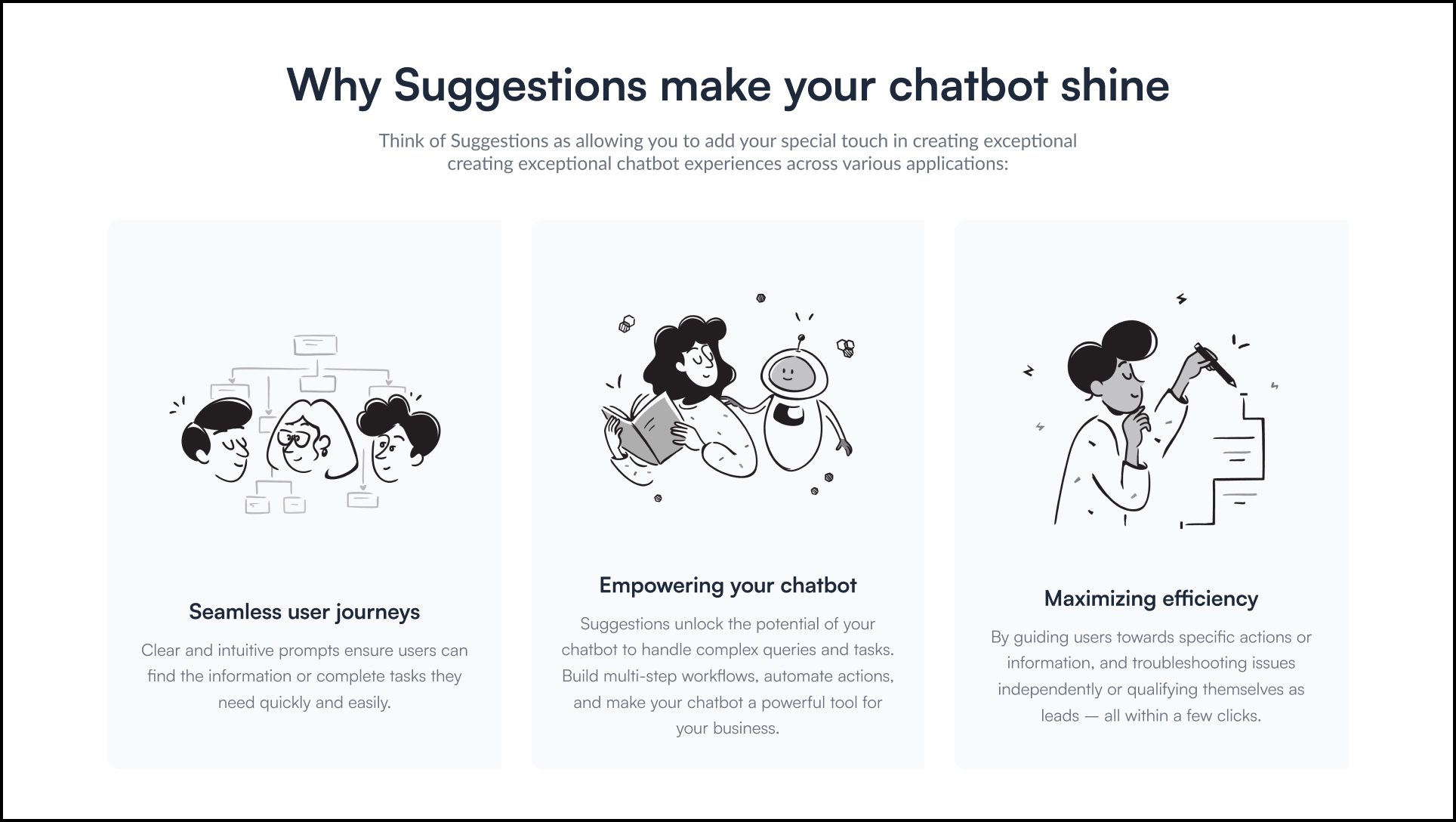
5. Customization
Your chatbot should reflect your brand’s identity.
For businesses, brand identity buildup is a major part of their marketing efforts. What better way to make a memorable impression than creating a chatbot that reflects your brand’s personality and tone!
Customization is an AI chatbot feature vital for an SMB like yours trying to make a mark amongst the noise.
Your chatbot should reflect your brand, but matching the conversation tone is just the start. Your chatbot must exhibit your brand’s persona, which comes with a dedicated name, its appearance, a unique proposition, and intent.
Adding a familiar visual element, such as an avatar, and using your brand colors can help with the recall factor.
A chatbot’s proposition varies with the business. Your bot should be the answer to your unique business needs and address your intent of usage–whether it is lead generation or just as simple as scheduling appointments or re-ordering products.
For your business: Interactions feel more natural and human and form deeper connections with your customers.
With Thinkstack’s free AI chatbot maker, you can design one that speaks with your brand’s voice, adapts visually to your branding, and functions exactly how you need it to. This is how Thinkstack helps you customize your chatbot to resonate with your brand and deliver a more personal experience to your users to get deep down into the details, check out this build your AI chatbot guide):
- Customize your chatbot's name, subheading, and the message input placeholder. You can also put in your brand info.
- Add a Bot Logo, select a background color for the header, and choose the color of the chat bubbles used by both the bot and the user.
- Customize your bot's Welcome Message, Inactivity Message, and other messages geared towards prompting your user and understanding their queries better.
- Enable your chatbot to acquire leads from your users. Customize it to your need; you can get creative. Change the information fields to collect rather than the old-school first and last names and emails.
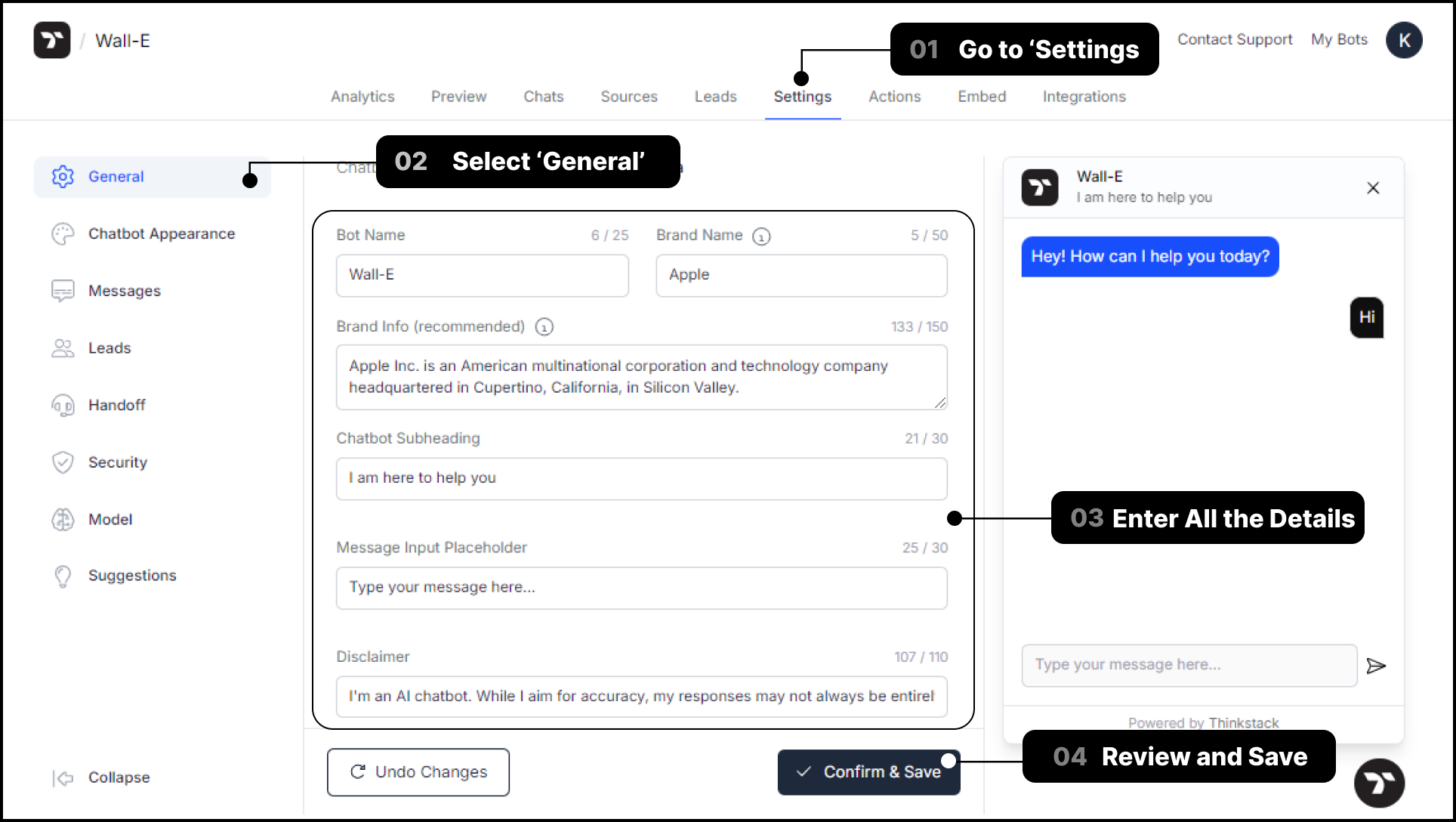
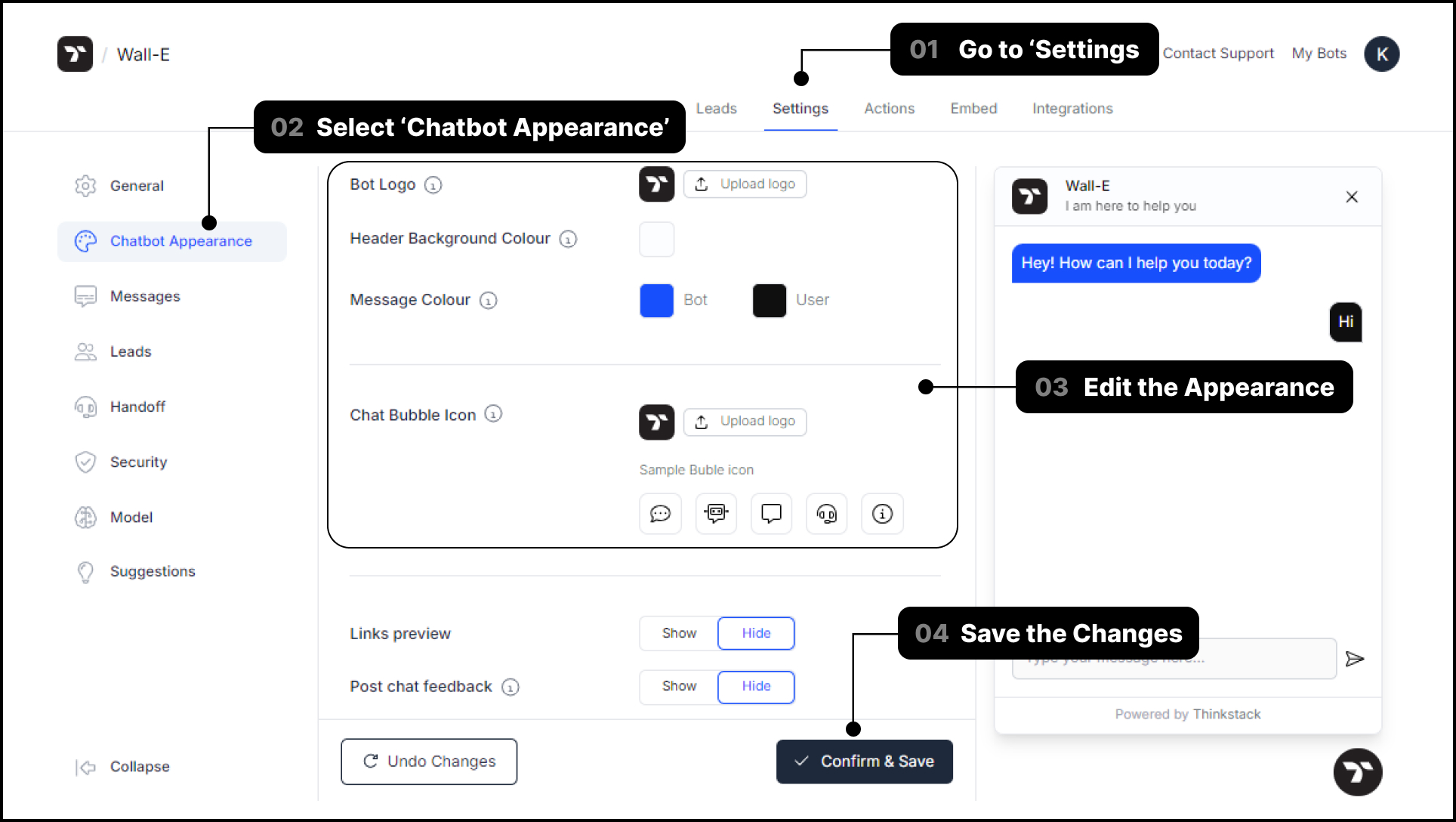
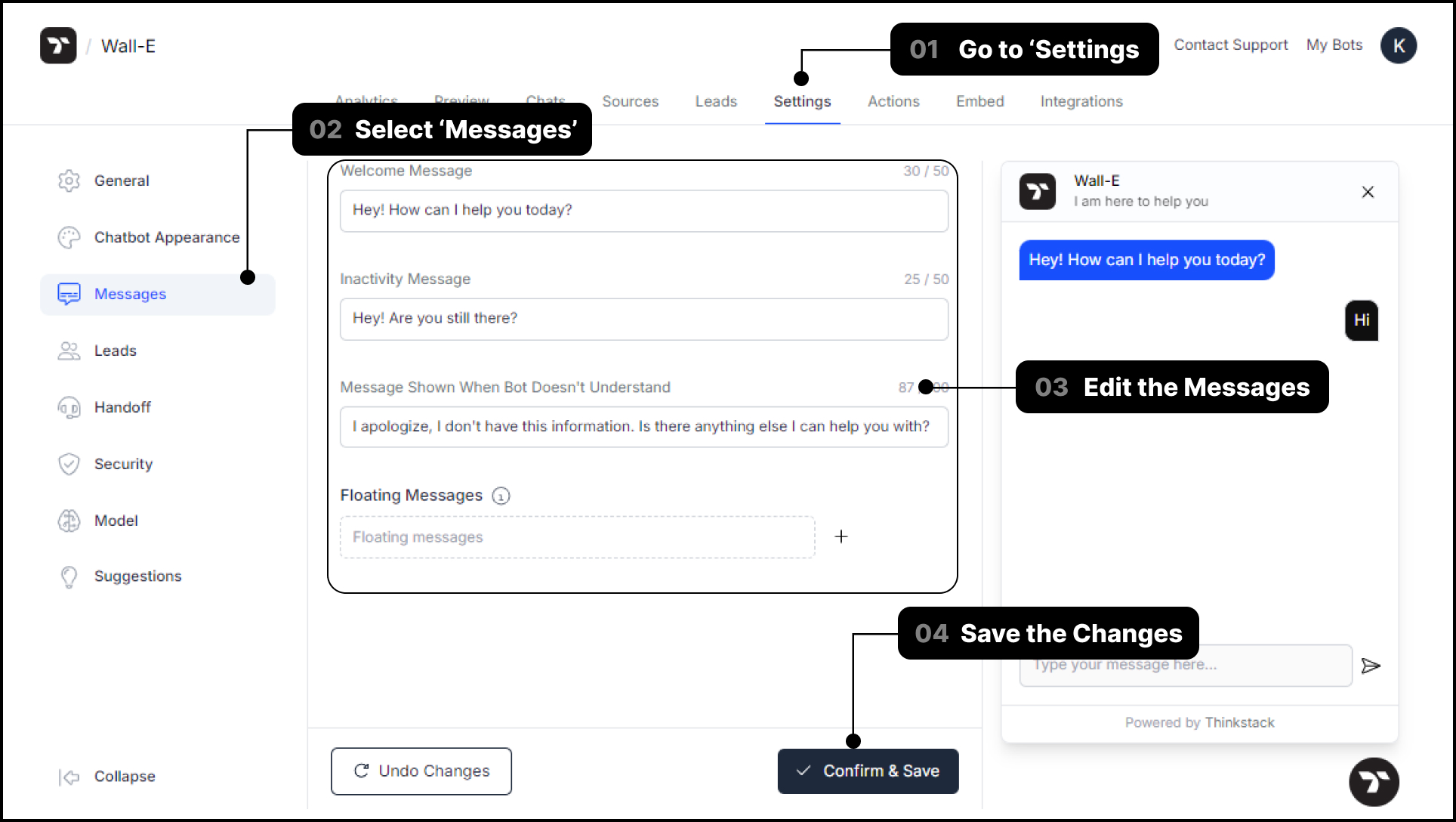
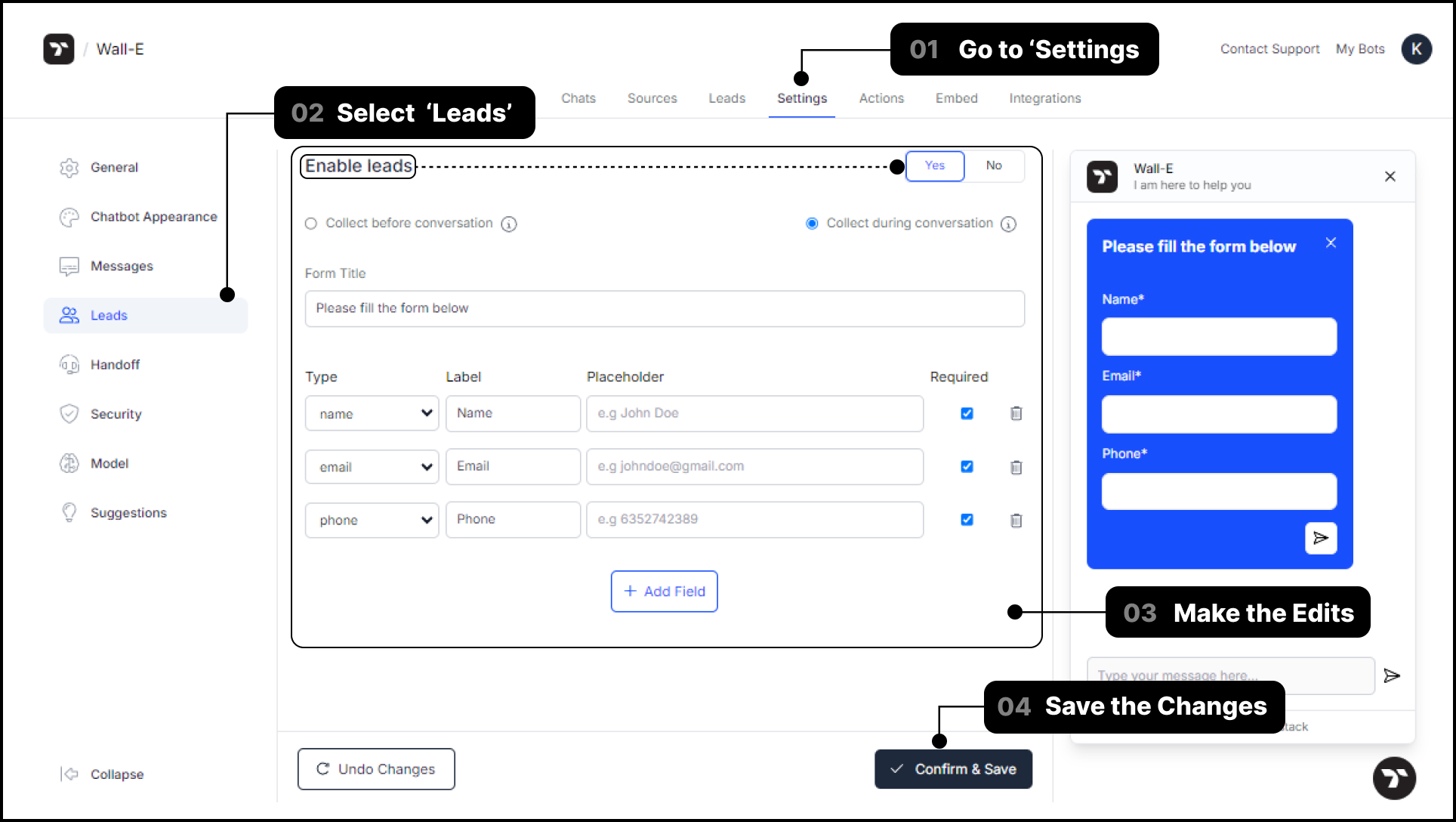
6. Automated task handling
Your chatbot should be able to handle repetitive tasks.
Humans are averse to the mundane. Repetitive tasks like filling up forms or scheduling appointments are off-putting for your customers. Your chatbot should be able to handle these routine tasks without error. This frees up your human agents to tackle more complex issues. It’s a win for everyone involved.
A Salesforce survey indicated that 64% of agents with AI chatbots could spend most of their time solving complex problems as opposed to 50% of agents without chatbots.
For your business: Reduces operational costs and increases efficiency effortlessly.
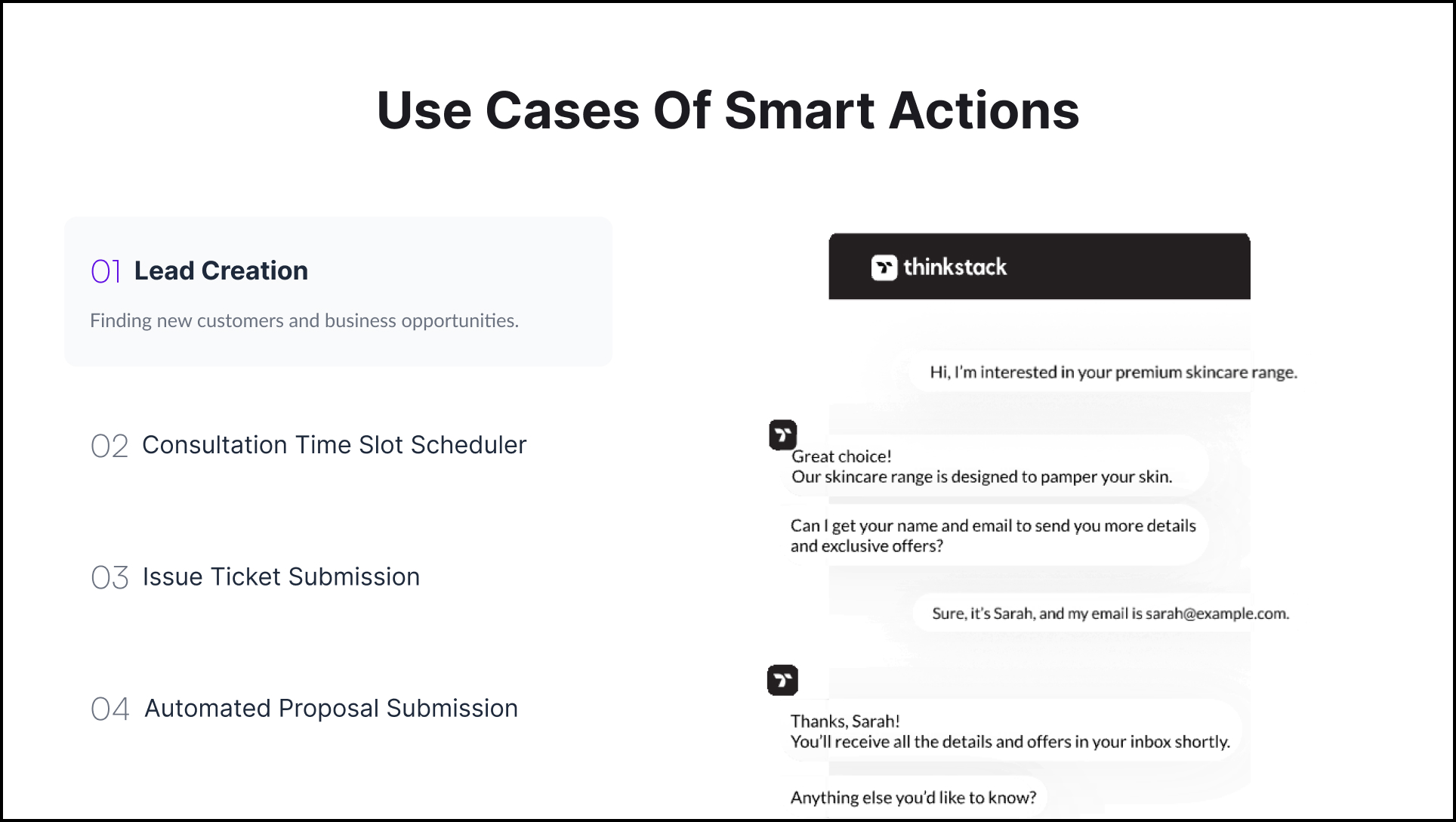
7. Human handoff capability
Your chatbot should be smart enough to know when to step aside.
Humans have a time book of patience. Running in circles with a chatbot that doesn’t get it is frustrating and counterproductive.
A smart chatbot knows exactly when to transfer reins to a human agent. Human handoff is an essential AI chatbot feature. When your chatbot reaches its limits, the transition to a human agent should be smooth. This feature is vital for handling complex or sensitive issues that require a personal touch.
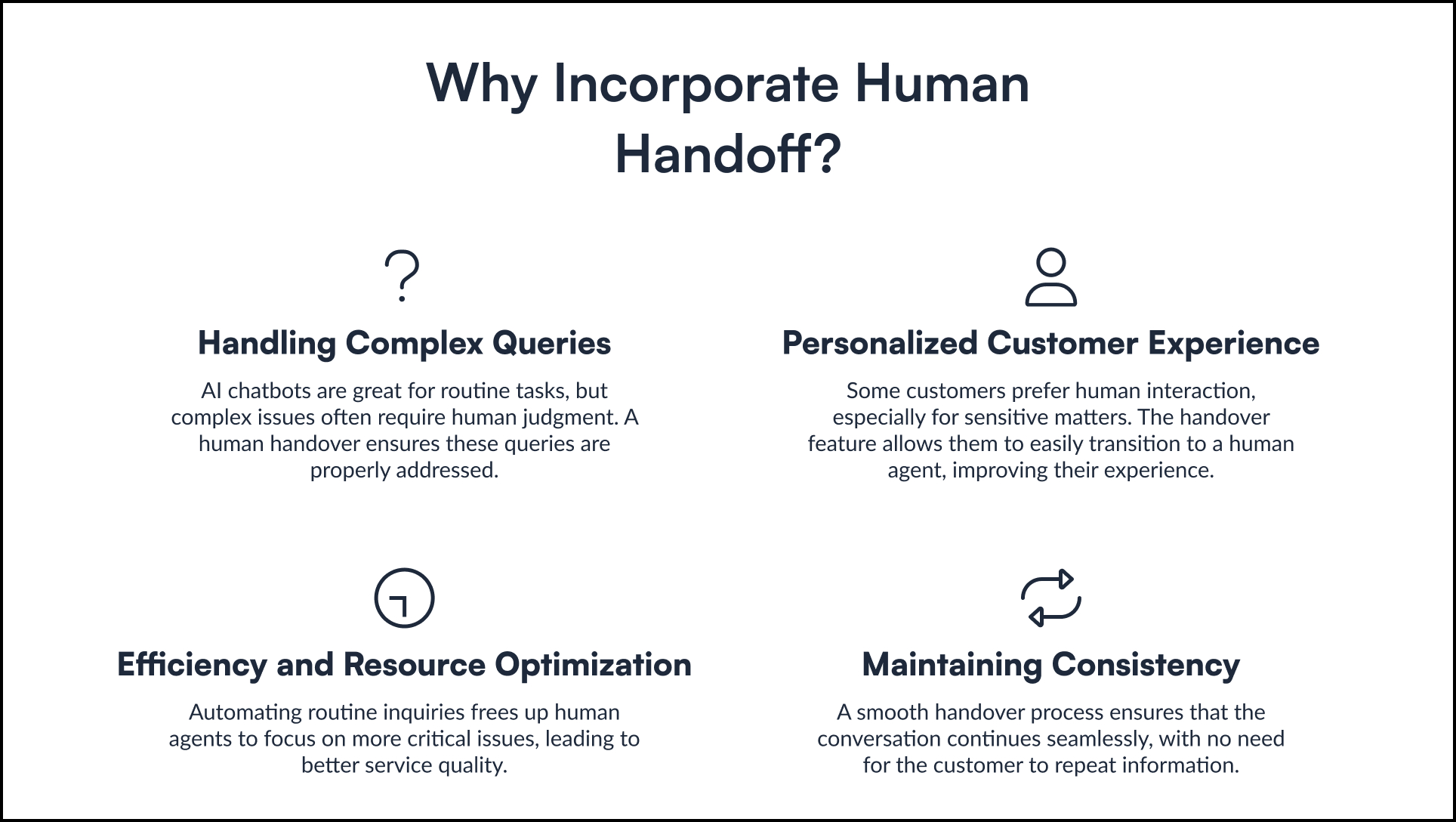
For your business: Timely intervention by human agents enhances customer satisfaction and keeps your brand’s reputation intact.
8. Multilingual support
Your chatbot should speak your customer’s tongue.
If your business operates globally, language should be the least of your worries. Multilingual support AI chatbot feature allows your chat assistant to communicate in multiple languages besides English.
A study was conducted by CSA Research on online shoppers in non-English speaking countries and found that 75% of the buyers preferred to purchase in their language.
This means people consider buying to be a very personal experience. A multilingual chatbot provides just that, creating a sense of unity over language. Plus, the non-existent language barrier ensures your chatbot delivers the same level of service irrespective of which part of the world your customers belong to.
9. Multi-Channel integration
Your chatbot should be able to manage cross-platform conversations.
Today’s customers are everywhere, and they expect your chatbot to move with them. Multi-channel integration allows conversations to follow irrespective of the platform without losing context.
According to a Salesforce report, 74% of customers surveyed have used multiple channels to start and complete a transaction.
Your chatbot should be able to keep the conversation going, no matter where it started–Facebook, WhatsApp, your website–without missing a beat. Platform-agnostic chatbots remove the need to re-explain issues, much like speaking to a human agent who already knows the entire conversation history.
For your business: Saves your business time and retains customer favor, ruling towards visitors becoming potential leads.
10. API integration
Your chatbot should be able to connect with any tool with no issues.
The changing expectations would soon be the death of simple FAQ chatbots. These are now expected to make customer-first service a lot easier for companies. One of the AI chatbot features that works to make this a reality is API integration.
Your chatbot can work with your existing software, from CRMs, payment gateways, inventory management systems, or e-commerce platforms. Moreover, there should be easy integration - quick without any heavy lifting. API integration enhances your chatbot’s functionality and access to data.
For your business: A unified workflow where your chatbot can pull or push data from various systems, making interactions more personalized and efficient.
11. Analytics and reporting
You should be able to measure and evaluate your chatbot’s performance.
The success of any effort needs to be evaluated and studied. Incorporating an AI chatbot into your workflow would inherently improve your customer service excellence. However, you need to know what works for your business and what doesn’t.
Analytics and reporting is an advanced AI chatbot feature that allows you to track how your chatbot interacts with users, revealing key data like customer behavior, response times, and success rates.
Chatbots are generally measured based on human-bot conversations on various parts of the customer’s buying journey. However, a very small portion of businesses employing chatbots are invested in monitoring their effectiveness. This feature can lead to enormous growth for small to medium-sized businesses where efficiency is everything.
If you are monitoring your chatbot, start by asking and measuring the right metrics:
1. How responsive is my chatbot?
Measured as:
- The number of visitors who see your chatbot pop-up.
- The number of visitors who receive a welcome message.
- The number of visitors who receive a welcome-back message.
- The number of visitors who are transferred to a human agent when the query gets complex.
2. How engaging is my chatbot?
Measured as:
- The percentage of visitors who interact with your chatbot and reach a certain message within the conversation flowchart of the chatbot.
- The time visitors stay on the site and the number of pages they visit because of your chatbot suggestions.
3. How convincing is my chatbot?
Measured as:
- The number of visitors who come for the second time or more.
- The number of visitors who fill up billing details or end up buying.
- The number of visitors who leave their email address or other contact information during their conversation with your chatbot.
- The percentage of people who find your chatbot helpful, based on a score scale at the end of a conversation.
With detailed reports, you can identify areas of improvement and make informed decisions to enhance your chatbot’s functionality and user satisfaction.
For your business: Improve decision-making by understanding what’s working and where your chatbot can be optimized.
The Right Combination of AI Chatbot Features can Change your Customer-First Game
Modern businesses like yours need chatbots to enhance business ROI and maximize chatbot ROI, all while delivering impeccable customer service. If your bot isn’t delivering all this, it’s time to upgrade. However, you need to truly ask yourself, as investments come with risks. Jot down the chatbot features your business needs and then decide on the requirements of your unique bot.
Here is why we think that Thinkstack is the answer for you
A no-code free AI chatbot maker platform, Thinkstack is a cool tool that helps you make smart bots.
Thinkstack chatbots are equipped with:
- Multilingual support (over 80 languages) and multi-channel integration (WhatsApp, Shopify, WordPress, Messenger, Slack)
- NLP and contextual understanding to assess user needs, offer proactive choices (Suggestions feature), and to quickly identify and hand over complex issues to human agents when necessary (Human Handoff feature).
- Automated task handling (Actions feature) to streamline operations and reduce costs.
- Machine learning and knowledge base integration to learn from and adapt to users' queries over time to provide directed solutions backed by your business data.
- Customization options to personalize your chatbot's appearance, tone, and functionality to match your brand identity and specific needs.
- Integration with software from CRMs, payment gateways, inventory management systems, or e-commerce platforms, be it global or local.
- Analytics dashboard that retains conversations for a period of 30 days to evaluate chatbot performance.
Ready to boost your business with the right AI chatbot features?
Explore Thinkstack’s easy-to-implement solution and discover how it can help your chatbot be awesome!
Frequently Asked Questions (FAQs)
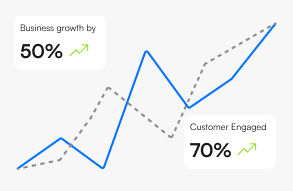
Grow Your Business with AI Agents
- Automate tasks
- Engage customers 24/7
- Boost conversions